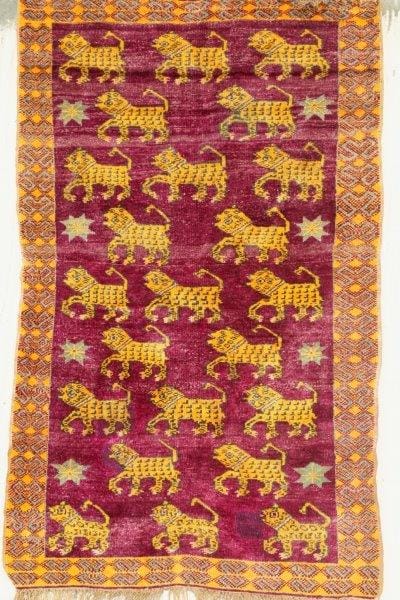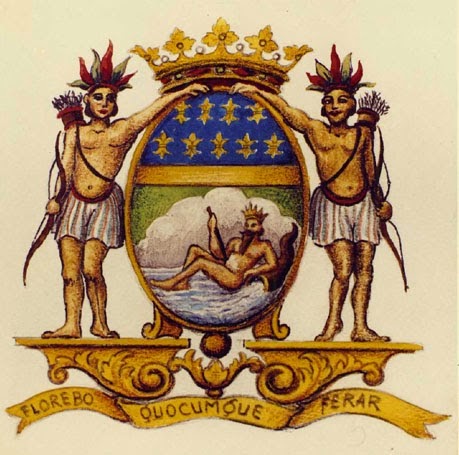14 Feb World’s Most Famous Carpet Traditions from Kashmir and Agra
[vc_row css_animation="" row_type="row" use_row_as_full_screen_section="no" type="full_width" angled_section="no" text_align="left" background_image_as_pattern="without_pattern" css=".vc_custom_1613361368117{padding-right: 15px !important;}" z_index=""][vc_column offset="vc_col-xs-12"][vc_column_text]Famous Carpet Traditions [caption id="attachment_3653" align="alignleft" width="375"] A prayer carpet. James F Ballard[/caption] Imagine a home, an airport, or a hotel with just bare floors room after room, no matter how lovely that floor might be. Through the ages, carpets have warmed our homes literally and visually, added to the decor, and provided insulation. In many cultures, they are regarded with enormous esteem, part of prayer ceremonies and religious places. The motifs are replete with history and cultural references, common across geographies and nations.
A prayer carpet. James F Ballard[/caption] Imagine a home, an airport, or a hotel with just bare floors room after room, no matter how lovely that floor might be. Through the ages, carpets have warmed our homes literally and visually, added to the decor, and provided insulation. In many cultures, they are regarded with enormous esteem, part of prayer ceremonies and religious places. The motifs are replete with history and cultural references, common across geographies and nations.07 Feb Historic Design Motifs, The History, Culture and Anthropology, and Relevance to Craft
[vc_row css_animation="" row_type="row" use_row_as_full_screen_section="no" type="full_width" angled_section="no" text_align="left" background_image_as_pattern="without_pattern" css=".vc_custom_1612749018323{padding-right: 15px !important;}" z_index=""][vc_column offset="vc_col-xs-12"][vc_column_text]Historic Design Motifs: There are recurring motifs in textile, architecture, tombs, and artifacts that we have seen through our lifetimes, and we are so used to them that we pass them by without a thought. Many of these motifs have long and complicated histories spanning time and straddling nations. An understanding of these is to understand culture and anthropology, and it is especially vital to craft. In earlier blogs, we have discussed the Paisley and the Cypress, arguably two of the most important. Today, let us look at a few more, perhaps less known but equally historical.31 Jan NATURAL INDIGO DYE INTERESTING GLOBAL HISTORY IN BRIEF
[vc_row css_animation="" row_type="row" use_row_as_full_screen_section="no" type="full_width" angled_section="no" text_align="left" background_image_as_pattern="without_pattern" css=".vc_custom_1612074858499{padding-right: 15px !important;}" z_index=""][vc_column][vc_column_text][caption id="attachment_3565" align="alignleft" width="368"] The Singh Twins painting of the story of indigo, showing both its value as well as the suffering caused[/caption]NATURAL INDIGO DYE: Blue is the color of the sky and the sea. It is the color of the sapphire and the tanzanite. It is a color we take so much for granted when we wear our denim and fleece that we forget that at one time, it was worth its weight in gold, worn only by the richest and royal. Indeed it was called Blue Gold. It also has a turbulent history associated with famine, slavery, and human suffering.
The Singh Twins painting of the story of indigo, showing both its value as well as the suffering caused[/caption]NATURAL INDIGO DYE: Blue is the color of the sky and the sea. It is the color of the sapphire and the tanzanite. It is a color we take so much for granted when we wear our denim and fleece that we forget that at one time, it was worth its weight in gold, worn only by the richest and royal. Indeed it was called Blue Gold. It also has a turbulent history associated with famine, slavery, and human suffering. 23 Jan About Silk Route, the Primary Goods or Ideas Traded, and Historical Impact
[vc_row css_animation="" row_type="row" use_row_as_full_screen_section="no" type="full_width" angled_section="no" text_align="left" background_image_as_pattern="without_pattern" css=".vc_custom_1611460407530{padding-right: 15px !important;}" z_index=""][vc_column offset="vc_col-xs-12"][vc_single_image image="3501" img_size="full" add_caption="yes" qode_css_animation=""][vc_empty_space][vc_column_text]Silk Route: History, as it is taught, has a strong and very narrow bias to the West. Most history concentrates on the rise of Europe, to the cost of ancient civilizations like China, India, and Persia. Yet, through much of ancient history, civilizations were concentrated around the Black Sea and eastwards. Harappa had a teeming population, as did Babylon and Mohenjo Daro. And at the center of this great melting pot of culture, religion, and language were the Silk Roads, a bridge between West and East, carrying goods, produce, ideas and disease.17 Jan Cypress Motif, The Mysterious Stories Representing Death and Eternal Life
[vc_row css_animation="" row_type="row" use_row_as_full_screen_section="no" type="full_width" angled_section="no" text_align="left" background_image_as_pattern="without_pattern" css=".vc_custom_1610939143383{padding-right: 15px !important;}" z_index=""][vc_column offset="vc_col-xs-12"][vc_column_text]Cypress Motif: When studying the history of motifs in the arts and crafts, we often read about the Paisley. But there is another motif, more mysterious, more philosophical, one that represents death and eternal life. And that is the Cypress. Many say that the Paisley was born of the cypress when a stray songbird sat on its very tip, bending it slightly. But let's go back to the beginning.08 Jan The Fascinating Textile Crafts of Japan
Posted at 15:25h in Art, Artisan, Culture, DESIGN, History, Sustainability, Technique by Mira Gupta 0 Comments
[vc_row css_animation="" row_type="row" use_row_as_full_screen_section="no" type="full_width" angled_section="no" text_align="left" background_image_as_pattern="without_pattern" css=".vc_custom_1610085540880{padding-right: 15px !important;}" z_index=""][vc_column offset="vc_col-xs-12"][vc_column_text]Textile Crafts of Japan : I had a pink hand-painted pajama set as a child, which came in an artful box, with the inside flap mirrored and beribboned. I loved this so much I never actually wore it but pulled it out at intervals to admire it. This was my first exposure to the miracle of Japanese crafts.19 Dec PUNK: CHAOS TO COUTURE. CULTURE VS ANTICULTURE IN ARTS & CRAFTS
[vc_row css_animation="" row_type="row" use_row_as_full_screen_section="no" type="full_width" angled_section="no" text_align="left" background_image_as_pattern="without_pattern" css=".vc_custom_1608419589666{padding-right: 15px !important;}" z_index=""][vc_column offset="vc_col-xs-12"][vc_column_text]Punk : The idea of perfection and details in designs are an intrinsic part of cultural crafts. This refined look of crafts has always fascinated me until the current prolonged situation with the pandemic made me realize why isn't design in crafts used for 'activism' or 'rebellion' or a cry for help for the change of current systems. I was inspired to think more in this direction after I recently revisited the Met's spring 2013 Costume Institute exhibition, PUNK: Chaos to Couture, which examined Punk's impact on high fashion from the movement's birth in the early 1970s. In this article, let us learn more about this exhibition and PUNK!12 Dec The Indo-French Art Connection
[vc_row css_animation="" row_type="row" use_row_as_full_screen_section="no" type="full_width" angled_section="no" text_align="left" background_image_as_pattern="without_pattern" css=".vc_custom_1607820803594{padding-right: 15px !important;}" z_index=""][vc_column offset="vc_col-xs-12"][vc_column_text]Indo-French Art : The historical connection between India and France goes back to the late 17th and 18th centuries when French ships arrived to set up trading centers in Pondicherry, the then Masulipatnam, and Surat, amongst others. Of course, the French were never as prominent in India as the English, finally losing the race to colonize India after the Battle of Plassey in 1757. The politics of the time also meant that early European painters in India were all or mostly British, establishing what came to be known as the Company School, a painting style combining English and Indian art styles. In India, early art schools in the then Bombay and Calcutta were also established by the British and taught art based on European classicism.05 Dec The Pahari School of Paintings: The Beautiful Indian Art
[vc_row css_animation="" row_type="row" use_row_as_full_screen_section="no" type="full_width" angled_section="no" text_align="left" background_image_as_pattern="without_pattern" css=".vc_custom_1607212846749{padding-right: 15px !important;}" z_index=""][vc_column offset="vc_col-xs-12"][vc_column_text]
Indian Art
[caption id="attachment_3273" align="alignleft" width="400"] Jain school of Gujarat.[/caption]
Jain school of Gujarat.[/caption]The history of painting in India goes back 2000 years, something that many do not realize, starting with the beautiful murals of Ajanta, which are interesting too because they show people wearing craft still extant. The 11th century saw the illustrated Pala manuscripts, painted on palm leaves, and the earliest example of miniature painting in India. The next development was the Jain school of Gujarat, which eventually lead to the Rajput tradition of miniature art. As it grew and developed, the Rajput tradition divided into two distinct schools, Rajput and the Pahari school, based in Himachal Pradesh, the hilly state in the north-west of India.











